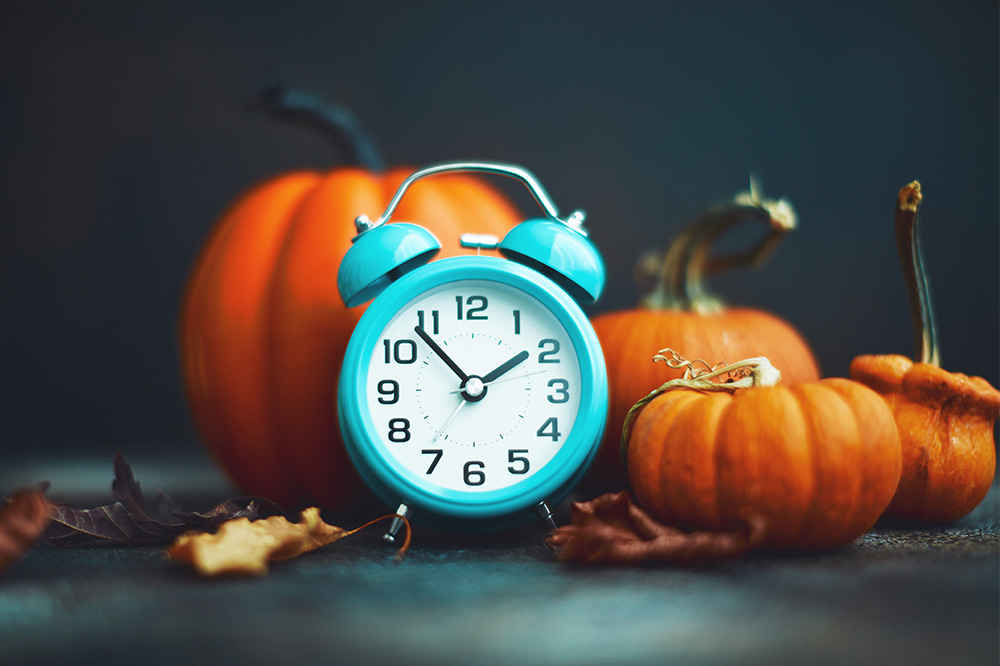
November 3, 2024, marks the end of Daylight Saving Time (DST) and back to Standard Time (ST) for this year. And while most people take the “fallback” in stride, thinking that means an extra hour of sleep, that may not be quite the case. The truth is, even if its effects only last for a day or two, the end of Daylight Saving Time can mess with your circadian rhythm, and ultimately, your forty winks.
Remember that circadian rhythms are not only impacted by external and environmental factors, but they’re also strongly influenced by light. So, when the biannual transitions into and out of DST alter the timing of our exposure to natural light, it’s easy to see where the problem lies.
According to Jay Olson, a Postdoctoral Scholar at McGill University who studies sleep and circadian rhythms, “Transitions to and from DST have effects similar to minor jet lag on a population scale. It’s like crossing one time zone, for example, flying from New York to Chicago. Most people won’t feel much (if any) jet lag.”
Olson goes on to say that while springing forward has a more profound effect on our sleep, falling back, while its effects may be minimal, is still on the hook. “The transition from ST to DST (in the spring) usually causes the most issues: people must wake up an hour earlier, which has been associated with a range of issues from car accidents to workplace injuries,” says Olson. “In the transition from Daylight Saving Time to Standard Time, people gain an hour of sleep; after the change, we’ll feel sleepy earlier (by the clock time).”
Daylight Saving Time And Your Circadian Rhythm
The transitions into and out of DST end up changing the timing of our exposure to natural light, which contributes to “misalignment between the circadian biological clock and the light/dark cycle,” according to a position statement from The American Academy of Sleep Medicine (AASM).
Moreover, the AASM notes (and points to research that shows) that body clocks may not fully adjust to DST even after several months. That could lead to a “permanent phase delay” and, in turn, “a perpetual discrepancy between the innate biological clock and the extrinsic environmental clock, as well as chronic sleep loss.” The statement also goes on to point out that this misalignment doesn’t just result in personal disruptions but “significant public health and safety risks.”
No doubt this is why the AASM has voiced its opposition to proposed legislation for a permanent daylight saving time. While they are all for eliminating the biannual time change, they argue the fixed time should be in Standard Time, not DST.
They’re not alone: Sleepopolis’ director of sleep health, Dr. Shelby Harris, agrees, noting that even if we get more daylight as we fall back, that’s not how human beings are wired. “It’s meant to be darker at night and to have the light help alert us in the morning,” she adds.
Likewise, Olson notes the real problem with switching to and from DST each year is the small but population-level circadian misalignment (improperly timed sleep and wake cycles), which has a range of negative consequences. Short-term consequences of circadian misalignment include decreased sleep efficiency, daytime sleepiness, and impaired cognitive performance. Over the long term, as in the case of shift workers, circadian misalignment can lead to diabetes, obesity, cardiovascular disease, and cancer.
Tips To Help You Prepare For The Time Change
Olson notes that the effects of turning the clocks back are typically short-lived; more often than not, “people can typically adjust to a single hour change in a day,” says Olson. “However, people who are ‘early birds’ — those who find it easy to wake up and feel most alert in the morning — may have a bit more trouble adjusting and may take an extra day,” he adds.
If you typically falter when you fall back, the following tips may help.
Try A Gradual Lead In
To mitigate the effects of falling back this fall, Olson suggests staying up slightly later (by around half an hour) the night before changing the clock to help ease the transition. (And if you need help figuring out exactly what time you should be in bed by, check out our Sleepytime calculator.)
Don’t Overload Your Calendar
Knowing your sleep schedule may be a bit off, you may want to keep your calendar light and plan accordingly when it’s time to fall back. For example, Olson suggests planning events the night after the change with the knowledge that you might feel tired earlier than usual.
Practice Good Sleep Hygiene
When you’re having trouble sleeping, you might think about tightening up on your sleep hygiene. This means maintaining a consistent and healthy sleep and wake routine — no matter how tired you feel in the early evening and sticking to your bedtime routine.
Give Yourself A Boost — Naturally
While it may be tempting to grab an extra cup of coffee to get over the hump, try boosting your energy levels naturally. Remember, you’ll probably feel tired earlier, so when that happens, skip the cup of joe, grab your walking shoes, and go for a brisk 30-minute walk instead.
Take Advantage Of The Sunlight
Remember that natural light is key to keeping our circadian rhythm in balance, so try to get out during the day and enjoy the sunlight. Natural light suppresses melatonin production, so if you’re feeling sleepy during the day, a little time outdoors might keep the sandman at bay until your normal bedtime comes around.
The Last Word From Sleepopolis
Whether we like it or not, most of us in the U.S. have to deal with yearly time changes. While daylight saving time has its advantages, the transition back to standard time can disrupt sleep and take a toll on our health. Understanding and preparing ahead can allow individuals to minimize that disruption and adapt more smoothly to the new schedule.



























